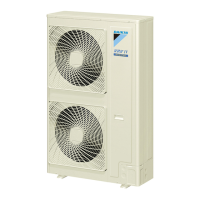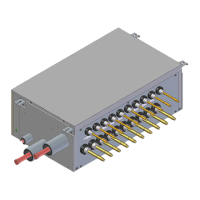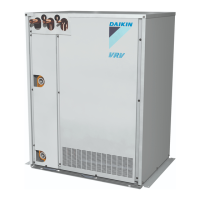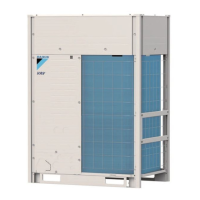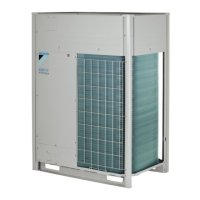16 Configuration
Installation and operation manual
28
RXYSQ4~6T8V/YB(*)
VRV IV-S system air conditioner
4P482275-1B – 2020.10
e Finishing tape
15.6 To check the insulation resistance
of the compressor
NOTICE
If, after installation, refrigerant accumulates in the
compressor, the insulation resistance over the poles can
drop, but if it is at least 1MΩ, then the unit will not break
down.
▪ Use a 500V mega-tester when measuring insulation.
▪ Do NOT use a mega-tester for low voltage circuits.
1 Measure the insulation resistance over the poles.
If Then
≥1MΩ Insulation resistance is OK. This procedure
is finished.
<1MΩ Insulation resistance is not OK. Go to the
next step.
2 Turn ON the power and leave it on for 6hours.
Result: The compressor will heat up and evaporate any
refrigerant in the compressor.
3 Measure the insulation resistance again.
16 Configuration
INFORMATION
It is important that all information in this chapter is read
sequentially by the installer and that the system is
configured as applicable.
DANGER: RISK OF ELECTROCUTION
16.1 Making field settings
16.1.1 About making field settings
To configure the heat pump system, you must give input to the
outdoor unit's main PCB (A1P). This involves the following field
setting components:
▪ Push buttons to give input to the PCB
▪ A display to read feedback from the PCB
▪ DIP switches (only change the factory settings if you install a cool/
heat selector switch).
Field settings are defined by their mode, setting and value. Example:
[2‑8]=4.
PC configurator
For VRV IV-S heat pump system it is alternatively possible to make
several commissioning field settings through a personal computer
interface (for this, option EKPCCAB* is required). The installer can
prepare the configuration (off-site) on PC and afterwards upload the
configuration to the system.
See also: "To connect the PC configurator to the outdoor
unit"[433].
Mode 1 and 2
Mode Description
Mode 1
(monitoring
settings)
Mode1 can be used to monitor the current
situation of the outdoor unit. Some field setting
contents can be monitored as well.
Mode Description
Mode 2
(field settings)
Mode2 is used to change the field settings of
the system. Consulting the current field setting
value and changing the current field setting
value is possible.
In general, normal operation can be resumed
without special intervention after changing field
settings.
Some field settings are used for special
operation (e.g., 1 time operation, recovery/
vacuuming setting, manual adding refrigerant
setting, etc.). In such a case, it is required to
abort the special operation before normal
operation can restart. It will be indicated in
below explanations.
16.1.2 To access the field setting components
See "To open the outdoor unit"[416].
16.1.3 Field setting components
The components to make field settings are as follows:
V
Y
H1P H2P H3P H4P H5P H6P H7P
MODE
TEST:
L.N.O.P.
DEMAND
C/H SELECT
HWL:
IND
MASTER
SLAVE
H8P
MULTI
BS2
SET
BS1
MODE
BS3
RETURN
BS2
SET
BS1
MODE
BS3
RETURN
BS4
TEST
BS5
RESET
BS4
TEST
BS5
RESET
H1P H2P H3P H4P H5P H6P H7P H8P
X1M
X2M
A1P
A2P
A1P
A2P
X1M
X2M
1 2
OFF
ON
DS1
1 2
OFF
ON
DS1
MULTIDEMANDL.N.O.P.SLAVEMASTERIND
TEST/
HWL
MODE
DS1 DIP switches
BS1~BS5 Push buttons
H1P~H7P 7‑LEDs display
H8P LED for indication during initialisation
ON ( ) OFF ( ) Flashing ( )
DIP switches
Only change the factory settings if you install a cool/heat selector
switch.
DS1‑1 COOL/HEAT selector (refer to the manual of the
cool/heat selector switch). OFF=not
installed=factory setting
DS1‑2 NOT USED. DO NOT CHANGE THE FACTORY
SETTING.
Push buttons
Use the push buttons to make the field settings. Operate the push
buttons with an insulated stick (such as a closed ball-point pen) to
avoid touching of live parts.
BS1 MODE: For changing the set mode
BS2 SET: For field setting
BS3 RETURN: For field setting
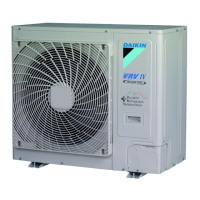
